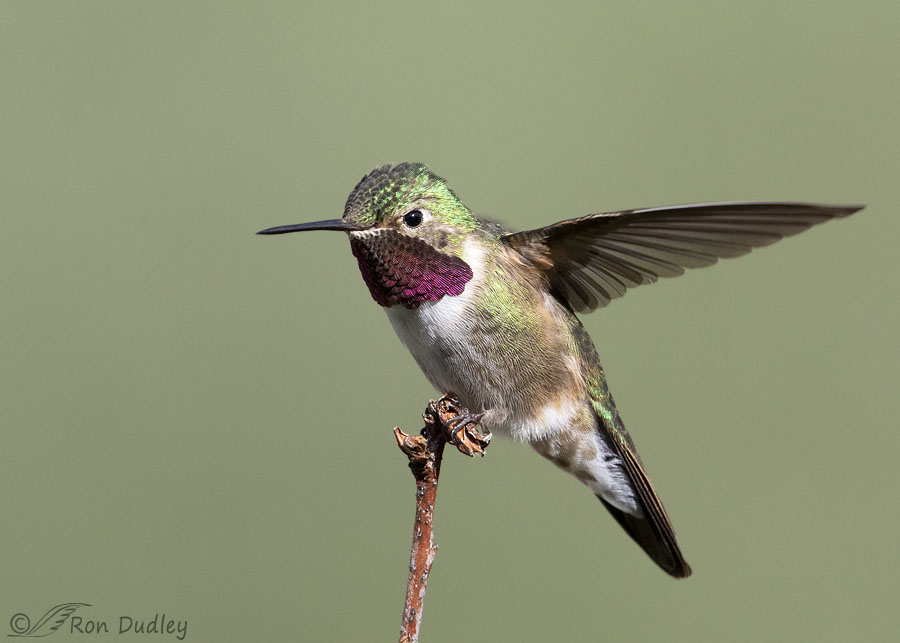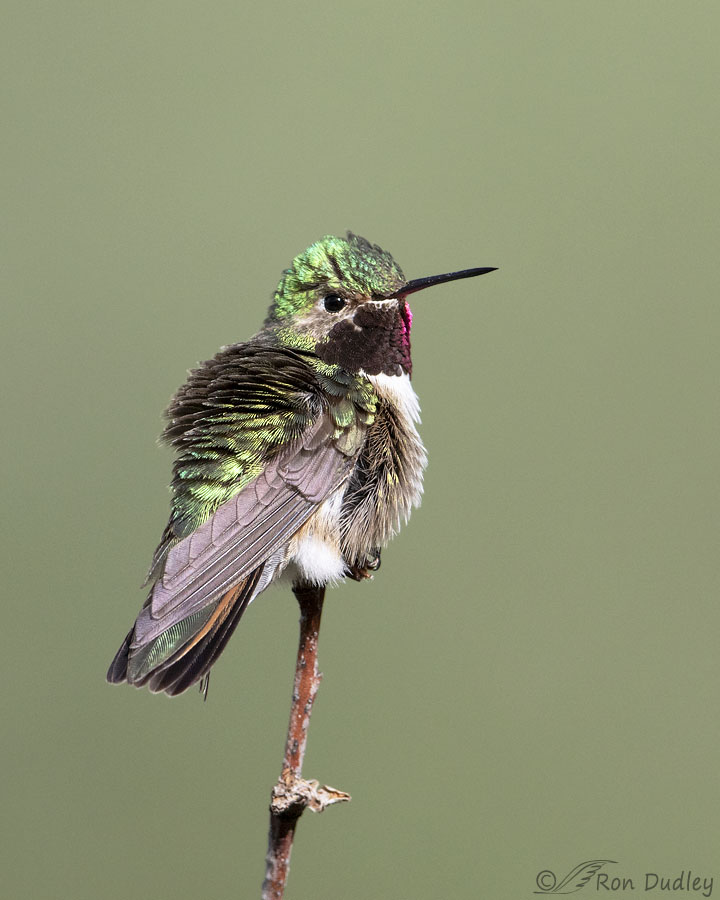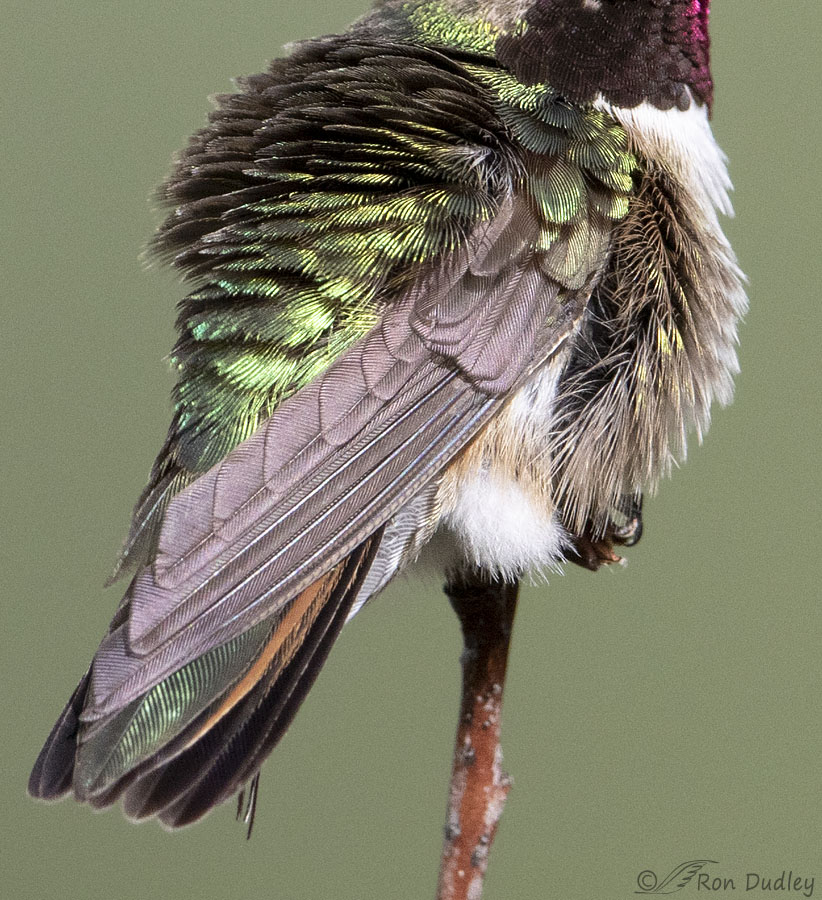Hummingbird feathers at the right angle and in the right light can be jaw-droppingly gorgeous. And I’m talking about far more than just the gorget.

1/3200, f/6.3, ISO 800, Canon 7D Mark II, Canon EF 500mm f/4L IS II USM + EF 1.4 III Extender, not baited, set up or called in
Two days ago I found the same male Broad-tailed Hummingbird on the same serviceberry twig I’ve photographed him on many times before.
Here I caught him as he was turning to face a different direction on his perch. I like the pose of course but the light angle isn’t ideal for showing his plumage at its most spectacular. And his feathers are flattened against his body so we don’t see anywhere near as much detail as we can when his feathers are fluffed.
In addition, at this angle we’re seeing mostly ventral feathers which don’t appear to have the structural variety and complexity of many of his dorsal feathers, nor do they exhibit as much iridescence (except for the gorget of course).

1/4000, f/6.3, ISO 800, Canon 7D Mark II, Canon EF 500mm f/4L IS II USM + EF 1.4 III Extender, not baited, set up or called in
But when he turned on his perch and fluffed his feathers I was gobsmacked by all the colors, layers, textures and patterns that were suddenly revealed, not to mention the additional iridescence.
As a biologist I’ve spent endless hours peering through microscopes so when I see something like this it’s my natural inclination to want to see even more magnified detail. In this situation a microscope wasn’t an option so I had to resort to the next best thing.
The photo is sharp so I cropped in as tightly as I dared.

His feather complexity is almost overwhelming when I think of the evolutionary processes that had to come to bear to produce it. We see an amazing amount of variety in feather structure in the same tiny bird and the textures, layers, colors and patterns seem to go on forever.
To me this is avian eye candy at its best.
This particular hummingbird has an attitude to match the boldness of his plumage. He’s fearless in chasing off other critters that have the audacity to approach ‘his’ serviceberry bush. On the morning this photo was taken I watched him attack a chipmunk in the interior of the bush and he chased off the male MacGivillray’s Warbler that I posted yesterday.
He’s one badass hummer.
Ron


Simply stunning, lovely and beautiful. Thank you Ron.
Ron, thank you for this great post. We have a broad-tail or two that visit our backyard feeder. They, however, don’t display their colors like the one your photos.
An amazingly beautiful bird.
Thanks
Funny to be eagle watching all day and come home to your post of a gorgeous hummingbird Big and small…. Love ‘em all
Big and small…. Love ‘em all
One extreme to the other. Thanks, Diana.
A wonderful short series! Great capture of the iridescence in the second and the wonderful, wonderful close up…which I always love because of the focus on detail…
Thanks, Patty.
Definitely avian eye candy, which while it has no calories IS addictive.
Thank you, EC.
“Avian eye candy” indeed!! Feathers are simply outrageous in their intricacy, complexity and evolutionary utility! They’re just so far beyond my imagination of what’s possible that it’s just ridiculous. Each feather is constructed differently to serve a purpose while also contributing to the overall beauty (sexual attractiveness?) or whatever other purposes we humans cannot yet comprehend!
I’m lucky. Each year, I get a full set of redtail and Harris’ hawk feathers to ponder. In addition to the colors inherent in the feathers that most humans would consider “drab” (and they’re just NOT drab), I’m gobsmacked by the multiple layers of down. In addition to the down feathers (that stick to everything), almost all the other feathers are equipped with even more down at their base! Even the big flight feathers, the primaries, secondaries and tail feathers, contribute to the complete down structure with down at their bases!
And for sheer elegance, those beautiful under tail coverts can’t be beat–well, except for the primaries, secondaries and tail feathers! I could go on and on until your eyes glaze over and you fall over dead! But I’d be preaching to the choir here!
Thanks, Laura.
On another note I love how you put Tim Larson in his place in a certain Facebook post.
Thanks Ron. And I didn’t even use the bad words that were TRYING to fall off my fingers, either!
Raptor feathers are NEVER dull! (Well, any bird feathers, for that matter…)
They certainly are amazing. I hope you one day get the chance to see some of the feathers under a microscope. But even here you need to see the feathers under different lighting conditions. The normal transmitted light of most microscopes does not begin to reveal the true complexity. Light needs to come from above and from various angles. The barb of the gorget feathers are flattened and act like tiny mirrors all reflecting light in unison and its light of very specific wave lengths to produce the brilliant colors. A simple compound microscope does not begin to reveal the incredible complexity. I wish I could share some of my images with you, but unfortunately all of those images (35mm slides) were destroyed in a flood (broken pipe) that coated and ruined all of them (and many 100s more) beyond being salvaged. (I also lost mitosis/meiosis photos, other microscope photos and many landscape and bird images. Many years worth of work that could not be saved and was not yet digitized.)
Wow, that was a huge and tragic loss, Dan.
Yes, the traditional light microscope is good for studying structure but not so much for the effects of optical physics.
I still have my scope from the old days. I’ve used it for looking at feathers many times but never hummingbird feathers.
Oh Dan, I’m so very sorry for that loss! Oh MY!
Oh, Dan, I’m so sorry!
“Avian eye candy at its best.” Indeed! Wonderful photos, Ron.
So glad I get to enjoy them in my own backyard, and I do love when they decide to flatten themselves on the top edge of the fountain to take a bath in the overflow or fly in to the misty overspray when I’m hand-watering plants.
Thanks, Chris. There’s been a few times when I’ve been hand watering that I thought one of them was going to poke my eye out.
My comment from yesterday — about agreeing with Dick and Lyle as well as being gobsmacked (funny, I used it yesterday and you’re using it today; GMTA!) by just how quick a bird can be and the way your first two shots drove that idea into my thick skull in a very unique and effective way — vanished into the Internet ether.
Today, I’m blown away by the feather detail and variation. I will admit that every so often, I get a bit emotional and overwhelmed by the true beauty and complexity of Evolution (and seeing a Saturn V rocket launch, but that’s for a different post). Your close crop and commentary hit my tear ducts just right. Where’s the Kleenex?
Marty, I never saw your comment and have no idea what happened to it. I guess the goblins of the internet were responsible…
Those Saturn V’s were something weren’t they!
We used to show Apollo 13 as part of one of our Earth Science/Physics combined units when we had our 3-year Coordinated Science program at our high school (complete with worksheets, physics problems and a big invention project, so not just watching a movie ). I’d have to hang out at the back of the classroom during the launch sequence because I’d always tear up — so that was 6 times each year! I watched the SpaceX launch, recently, and had another onslaught of Ninja Onion-Cutters, so I guess it isn’t just Saturn Vs.
). I’d have to hang out at the back of the classroom during the launch sequence because I’d always tear up — so that was 6 times each year! I watched the SpaceX launch, recently, and had another onslaught of Ninja Onion-Cutters, so I guess it isn’t just Saturn Vs. 
What amazing shots! Thanks for sharing Ron!
Thanks, Charlotte.
Absolutely marvelous! Hummingbirds are one of my most favorite birds, and we have a lot of them here in Berkeley! they sometimes take baths at the fountain next door which is a delight!
I’ll bet it’s a delight, Nicky. I don’t believe I’ve ever photographed a bathing hummingbird in the wild.
Nice photograph. I know it isn’t completely natural, but I would like to see your artistry applied to a hummingbird feeder. Their antics are wonderful as they duel in mid air. I know you could post some spectacular shots under those circumstances. It is a favourite pastime to watch them on a neighbour’s patio.
John, I just don’t enjoy photographing at feeders very much so I rarely do it. I much prefer to be in a more natural setting photographing natural behaviors.
I sure enjoy watching them at my feeder though.
Hs is beautiful. Very good feather quality.
He sure is. Thanks, April.
My favorite bird. The detail in the third photo is great. Even having been to numerous hummingbird counts and tagging processes I have never seen this much detail. They are amazing creatures. Thanks.
Betty, one thing I love about my lens is that it often allows me to see things that can’t even be seen in a bird in the hand.
Jaw-dropping gorgeous! Their feathers and the ability of the colors to look different depending on angle and life is amazing! VBG! The feather detail in the 3rd photo is amazing….. We humans sure are “ugly ducklings” when it comes to “plumage…….
Their feathers and the ability of the colors to look different depending on angle and life is amazing! VBG! The feather detail in the 3rd photo is amazing….. We humans sure are “ugly ducklings” when it comes to “plumage……. 
We sure are. Thanks, Judy.
Such beauty, joy, wonder and energy in such a little package.
“‘Hope’ is the thing with feathers”, indeed.
““‘Hope’ is the thing with feathers””
These days especially, Lyle. There seems to be very little of it left in many other arenas.
I think that the second image ( and its detail shot ) just has to be the all
time BEST hummingbird beauty shot, anytime, anywhere ! The detail of
the stacking of the feather patterns, and the all-over iridescence is just
breathtaking– he looks like a small metallic pinecone–WOW !
I’m delighted that you love it so, Kris. I feel pretty much the same way.
Your photos are fantastic……such amazing creatures!
They sure are. Thanks, Lynnette.
Killer photos of a fantastic bird. What exquisite detail!
Thank you, Joanne.
Beautiful coloring and outstanding photos. Love hummingbirds and how territorial they are. We really enjoying watching them outback and they will pretty much chase anyone and anything that comes into whatever they consider theirs. That last photo showing the colors and layers and complexity of those feathers is truly remarkable.
Thanks, Everett. I don’t think hummers know what fear is, males in particular.
Just WOW! Nature never fails to boggle my mind and fill me with wonder. Thanks for these beautiful pics!
Thank you, Gretchen.
Absolutely beautiful! The detail is fantastic. The cropped photo almost has the look of a very finely fabricated work of metal art. The colors are the prize…beautiful.
“The cropped photo almost has the look of a very finely fabricated work of metal art.”
Interesting observation, Kathy. You’re right, it does.
Spectacular! Thanks for providing us with a closeup of the feather complexity…mind-boggling.
I’m glad you enjoyed the tight crop, Alison. Sometimes I wonder if it’s only me who has a hankering for such things.
Wow, what a beauty of a bird. The coloring of a Hummingbird is breathtaking, considering how small they are. I love how the coloring around their neck changes. All they have to do is tilt their head a little, and the purple becomes black, then back to purple again. Have a good 4th!
Jean, that “coloring around their neck” is called their gorget and as you say it’s breathtaking.